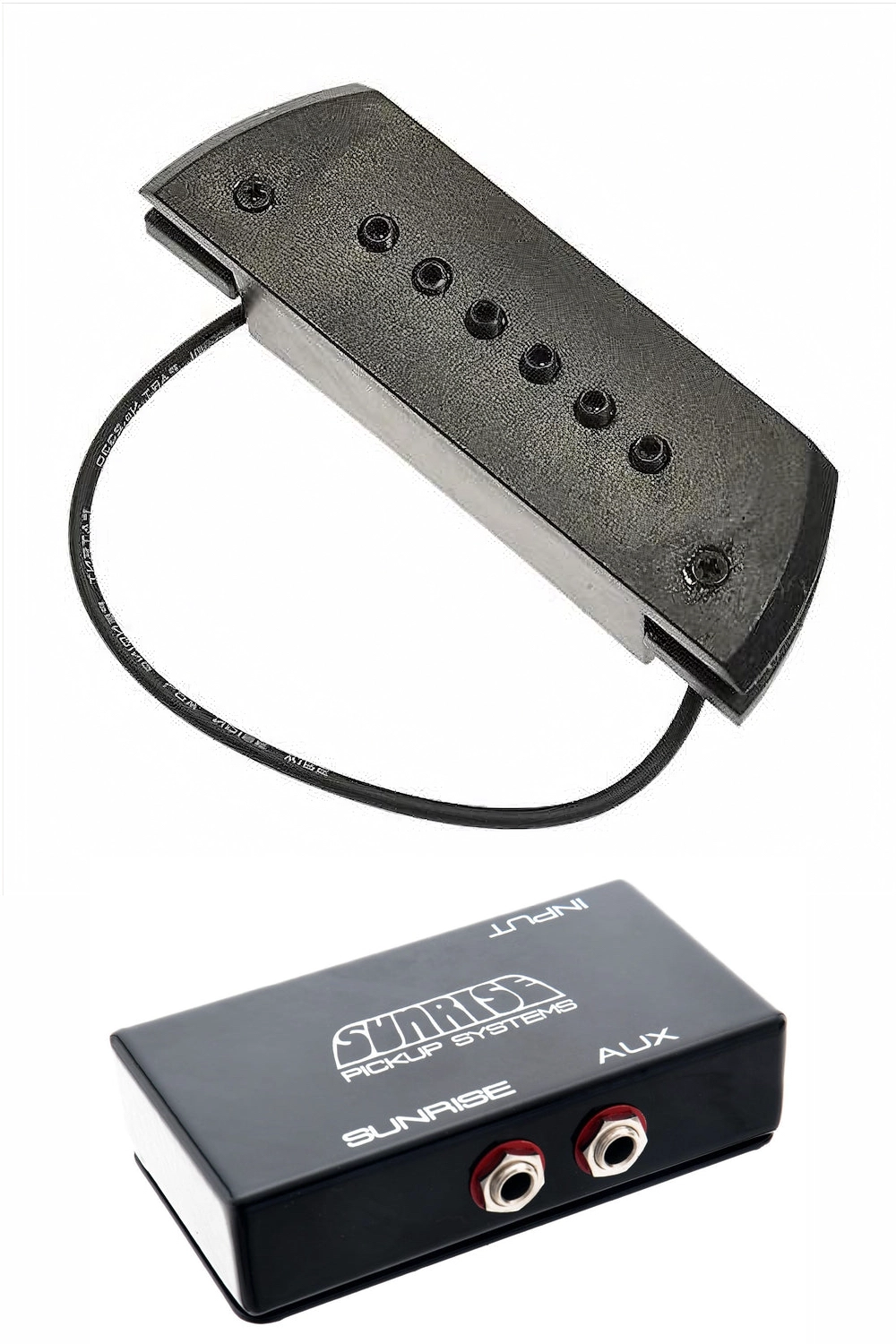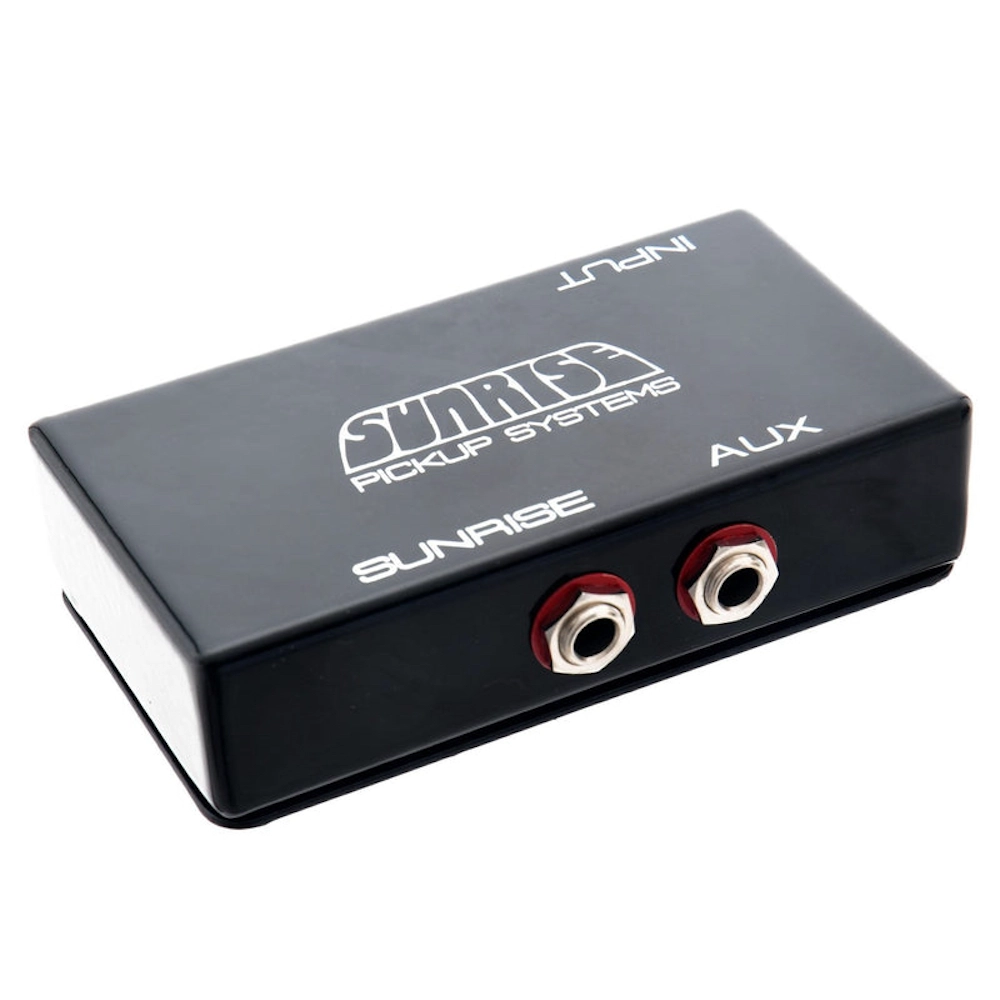Sunrise Acoustic Guitar Pickup

This pickup and matching preamp represents the ultimate in the uncompromising search for a truly acoustic guitar sound capable of high sound pressure levels.

This pickup and matching preamp represents the ultimate in the uncompromising search for a truly acoustic guitar sound capable of high sound pressure levels.
Jim Kaufman introduced the Sunrise pickup in the 1980s. It was a humbucker design with body sensing capabilities that easily mounted in the soundhole. Performing musicians were quick to welcome the Sunrise due to its ability to deliver an impressive representation of the sound of an acoustic guitar at extremely high sound pressure levels (volume), all with unprecedented control over feedback. For stage performances, the Sunrise quickly became the standard by which other pickups were measured.
In my world, right up there with "a place for everything and everything in its place", is the maxim "highest and best use." When determining market value of real property, usage that would yield the highest returns is considered, regardless of current usage, hence "highest and best use." Stretching that concept into the realm of acoustic guitar pickups, if I need to crank up the volume for tens of thousands of adoring fans and intend to move my guitar more than an inch or two from its original position when I begin my 1 to 3 hour performance, what I most likely do not want is an uber-responsive guitar carefully positioned in front of a studio condenser microphone. Controlling feedback under such conditions requires some serious sound engineering, well out of my control.
At high sound pressure levels, piezoelectric SoundBoard Transducers need heavy-handed equalization to remain contained and, as a result, can end up sounding rather thin. While (what I think of as) the SBT's heavy-duty cousins, the Under Saddle Transducers, may handle a bit more volume prior to howling through the speakers, the accompanying and ubiquitous piezo "quack" is not the most appealing sound to listen to.
When selecting a pickup for such a stage performance, "highest and best use" really means a magnetic soundhole pickup needs to be included in the mix.

Single-coil or double/dual-coil ("humbucker") pickups, considered required equipment in the electric guitar world, are often relegated to niche positions in the minds of many so-called acoustic purists (says me, a former acoustic purist). Many early offerings, as well as many inexpensive models, do little to convince anyone that they will accurately reproduce the sound of your favorite acoustic guitar. Simply put, just as most piezo pickups produce a piezo "quack," most magnetic soundhole pickups installed on acoustic guitars sound like, well, electric guitars.
The Sunrise is definitely not inexpensive. At the time of this writing, the Sunrise is available for $479.00. For comparison purposes, the DiMarzio Black Angel sells for $169.00. Does the Sunrise sound that much better than any of its competitors? I happen to think so and enough well-respected musicians have thought so, and enough of their fans have apparently agreed, that it may be worth finding out for yourself.
The Sunrise is big. And it is heavy. And, regardless of what it is plugged in to, I have never really cared for how it sounds all by itself. What I mean by that is, it sounds too similar to just about every other magnetic soundhole pickup available.
HOWEVER, when I added one simple piece of gear into the signal chain ...

... everything changed! This Sunrise Buffer Box (preamp) was the piece of kit that I hadn't wanted to pay for and thought I could do without. What I ended up really "paying for" was making such an uninformed decision. I had failed to realize how critical a component this little 18 volt preamp was. I never cared for the sound of the Sunrise all by itself, and foolishly tossed a nearly $500 pickup in a drawer where it sat, untouched, for years. The Buffer Box added that body resonance factor back into the mix, and the overall sound of the Sunrise improved dramatically!
To be fair, the cost of a Sunrise Buffer Box is nothing to sneeze at. At the time of this writing, the single-channel S-B1 sells for $339 and the 2-channel S-B2 will set you back an additional $60 for a total of $399. Investing $800 to $900 into a magnetic soundhole pickup/preamp system may or may not be feasible for you. But before you make a decision, make certain you have all the facts.
Fact #1: Jim Kaufman only makes a select number of pickups and preamps each year. When they are gone, they are gone! At that point, if you really want one you will either wait until next year or try to purchase one used. NOTE: There is little fear of buying used, as the Sunrise ships with a transferrable lifetime warranty. Very smart business, in my opinion.
Fact #2: Sunrise only sells one pickup; all the number/letter designations pertain to the cable and connector configurations. The S-1 and the S-2 refer to the same pickup. The S-1 includes a permanently attached 8" wire, nothing more. You supply your own jack. The S-2 comes with a complete installation kit, including a Switchcraft 2-Channel endpin jack, Switchcraft in-line mini connectors, a section of Mogami cable, hold-down clips and a hex wrench.
Fact #3: Pair the pickup with a preamp if you want your guitar to sound remotely like you may have heard your favorite performer's guitar sound (arguably, it should be an S-B1 or S-B2, though some have sworn they can get the sound they want with their own choice of gear). This is the only way to take advantage of the "body resonance" capability of the Sunrise.
Fact #4: Cut the mid's out of the mix. Failing to do so will result in more than just a hint of that familiar electric guitar sound.
Fact #5: Boost the bass at or around 90 Hz. It will fatten up the low end to simulate a resonant acoustic guitar.
Fact #6: Add some shimmer to remove the sterile sound of a magnetic pickup. Pick your own effect, but you need a little something to sound more similar to plucked strings on an acoustic guitar. A bit of Chorus may be all that is necessary to put that smile on your face and elicit that knowing nod when you realize you definitely have a really nice sounding solution.
Fact #7: Get the 2-Channel S-B2 Buffer Box (preamp) and wire a second pickup that can provide a bit of "air" into the mix. I prefer a mic, but you can also add in an SBT or even a UST. In my opinion, this is necessary for any stand-alone magnetic soundhole pickup - these will always sound better if they are part of a multi-source pickup system. Having a magnetic pickup in the mix, you gain access to a myriad of effects boxes that just don't work well with mics or piezo pickups.
Fact #8: You can turn up the volume, as in, really turn it up! Sporting a 116 dB feedback threshold, the Sunrise pickup/buffer box combination is arguably the most robust solution for acoustic guitarists with high sound pressure level needs.
You can read more about the Sunrise pickup on the website » Jim Kaufman's Sunrise Pickup Systems.